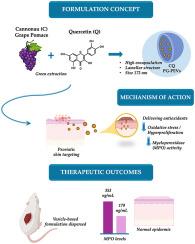Grape pomace and quercetin: a synergistic approach using PG-PEVs for Psoriasis treatment
IF 4.9
3区 医学
Q1 PHARMACOLOGY & PHARMACY
Journal of Drug Delivery Science and Technology
Pub Date : 2025-09-17
DOI:10.1016/j.jddst.2025.107544
引用次数: 0
Abstract
Psoriasis is a chronic inflammatory skin disorder that affects millions worldwide and poses significant therapeutic challenges due to the adverse effects of conventional treatments. In this
study we explored a sustainable approach based on Cannonau grape pomace extract, a winemaking side-stream rich in antioxidant polyphenols, combined with quercetin, to develop effective treatments for psoriasis. The extract was obtained using an eco-friendly extraction process and incorporated into phospholipid vesicles containing propylene glycol (PG-PEVs), which exhibited favourable physicochemical features: small size (∼77–172nm), homogeneously dispersed (PDI ∼0.29), highly negative zeta potential (∼−45 mV), high entrapment efficiency (≥82 %), and long-term stability over 18 months. Biological evaluations revealed the high biocompatibility of the formulations (≥80 %), and their ability to protect keratinocytes from oxidative stress and hyperproliferation, hallmarks of psoriasis.
In a psoriasis-like murine model, PG-PEVs significantly reduced inflammation, neutrophil infiltration, and epidermal hyperplasia, as confirmed by decreased MPO levels (from ∼353 to ∼179 ng/mL) and improved skin architecture observed through histological analysis, which outperformed the effects of the natural chemicals in dispersion. These findings highlight the therapeutic potential of Cannonau pomace extract-loaded PG-PEVs as a promising, sustainable dermatological strategy. Moreover, this study supports the valorisation of agricultural side-streams into high-value cosmeceuticals, aligning with circular economy principles.

葡萄渣和槲皮素:利用PG-PEVs治疗银屑病的协同方法
牛皮癣是一种慢性炎症性皮肤病,影响着全世界数百万人,由于传统治疗的副作用,它给治疗带来了重大挑战。在这项研究中,我们探索了一种可持续的方法,基于加农葡萄渣提取物,一种富含抗氧化多酚的酿酒侧流,结合槲皮素,开发有效的治疗银屑病的方法。该提取物采用环保提取工艺获得,并加入到含有丙二醇的磷脂囊泡(PG-PEVs)中,具有良好的物理化学特性:尺寸小(~ 77-172nm),分散均匀(PDI ~ 0.29),高负zeta电位(~ - 45 mV),高包封效率(≥82%),并具有超过18个月的长期稳定性。生物学评价显示,该制剂具有较高的生物相容性(≥80%),并且能够保护角质形成细胞免受氧化应激和过度增殖(牛皮癣的特征)的影响。在牛皮癣样小鼠模型中,PG-PEVs显著减少炎症、中性粒细胞浸润和表皮增生,这一点通过MPO水平降低(从~ 353降至~ 179 ng/mL)和组织学分析观察到的皮肤结构改善得到证实,其效果优于天然化学物质的分散效果。这些发现突出了猪粪渣提取物负载PG-PEVs作为一种有前途的、可持续的皮肤病治疗策略的治疗潜力。此外,本研究支持农业侧流向高价值药妆的增值,符合循环经济原则。
本文章由计算机程序翻译,如有差异,请以英文原文为准。
求助全文
约1分钟内获得全文
求助全文
来源期刊
CiteScore
8.00
自引率
8.00%
发文量
879
审稿时长
94 days
期刊介绍:
The Journal of Drug Delivery Science and Technology is an international journal devoted to drug delivery and pharmaceutical technology. The journal covers all innovative aspects of all pharmaceutical dosage forms and the most advanced research on controlled release, bioavailability and drug absorption, nanomedicines, gene delivery, tissue engineering, etc. Hot topics, related to manufacturing processes and quality control, are also welcomed.

 求助内容:
求助内容: 应助结果提醒方式:
应助结果提醒方式:


